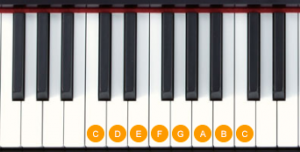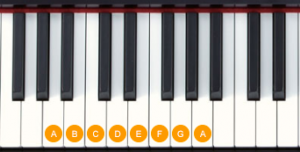You might have noticed that C major and A natural minor scale sharing the same keys. The difference is only noticeable because the referenced root key is different. This is also known as modes. Major and minor are probably the most popular modes, but there is more to it. Of course C major and C minor are two different modes of the same root key, where C major and A minor are two different modes with different root keys, but they share the same notes in the scale.


So, the notes A to G are defined as major scale if C is the root key. However, when the root key is A, the scale is a “A natural minor scale”. Same keys with different root notes resolve to different modes.
How many modes are there? Well in modern western European Music the scale has seven notes, each note could be defined as root key. This leads to seven modes known as:
- Ionian (major scale)
- Dorian
- Phrygian
- Lydian
- Mixolydian
- Aeolian (natural minor scale)
- Locrian (or also called Hypophrygian)
If you look at the scale pattern in half and whole notes, you see that the scale is actually shifting to the left for each next mode:
If all the modes share the same notes, one could easily come to the conclusion that all modes sounds similar. But the tonic reference is really making the difference here. Some would say one mode is brighter than others.
Besides the happy Ionian sound and the sad Aeolian sound that are quite popular, there are more modes to discover. Each mode has a typical characterising sound that you should use in your repertoire to make your music more interesting.
You should not mix up modes with scales. I did not cover all available scales, only the common ones. There are scales with additional notes or even with less notes. For example a whole tone scale has 6 notes (C, D, E, #F, #G, #A) and there are only two whole tone scales available (one starting from C, and one starting from #C). A halftone scale has 12 notes and there is only one halftone scale that exists. Maybe I will add another post only about scales, since there is also a lot to discover.
If you want to get some more information about modes, there is a great Youtube Video from Rick Beato with listening examples on the piano and further explaination to the characteristic of each mode: https://www.youtube.com/watch?v=8HJ5mBb9Pgo and there is also a new video about modes vs scales: https://www.youtube.com/watch?v=vZ8QzZ8GGo4
This short introduction is not covering all aspects of modes. If you want to learn more about modes, I would recommend reading the wikipedia site and check out more Youtube videos from Rick Beato.







